Mechanisms of the performance enhancement by hetero - Gate dielectric in tunnel field - effect transistors
The hetero-gate dielectric (HGD) structure has recently been demonstrated experimentally
in tunnel field-effect transistors (TFETs) to enhance their electrical performance. In this
paper, we adequately examine the mechanisms that the HGD works to ameliorate the
electrical characteristics of TFETs. A typical bulk p-i-n TFET structure is used to exclude
the uncertain effects of body factors on the role of HGD. It is showed that the subthreshold
swing is improved by the presence of a conduction band well near the source/channel
junction, but the swing improvement is limited by the appearance of the hump effect when
the local potential well approaches the source. By analyzing the roles of dielectric
heterojunctions at source- and channel-sides separately, it is found that the on-current
enhanced by the source-side heterojunction is about 5 times larger than by the channel-side
one. The reason is that the source-side heterojunction directly modulates the on-state tunnel
width, whereas the channel-side heterojunction indirectly affects the on-current through
modulating the subthreshold-state tunnel width. Exactly understanding the mechanisms of
the performance enhancement by HGD is important in studying the optimal design of HGDTFETs.
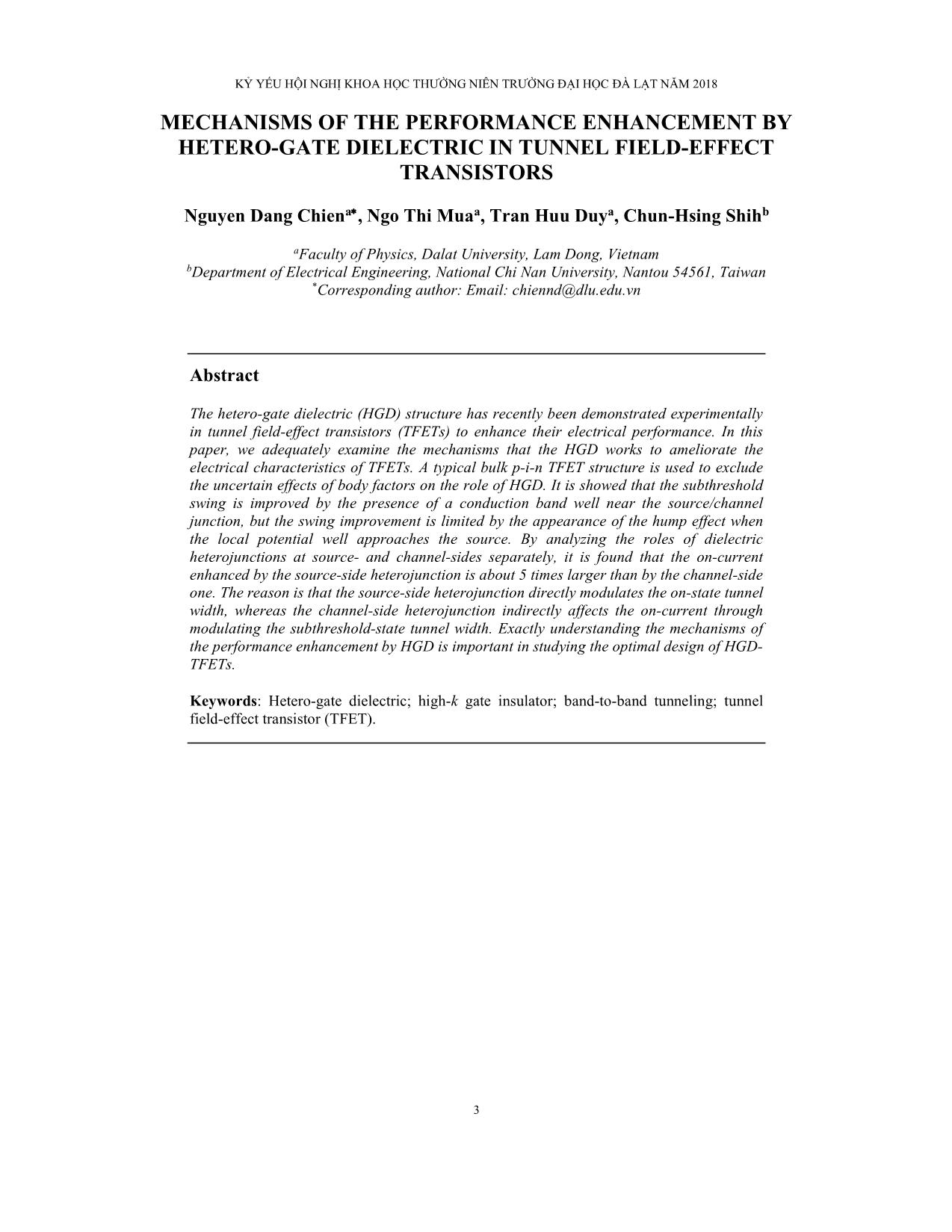
Trang 1
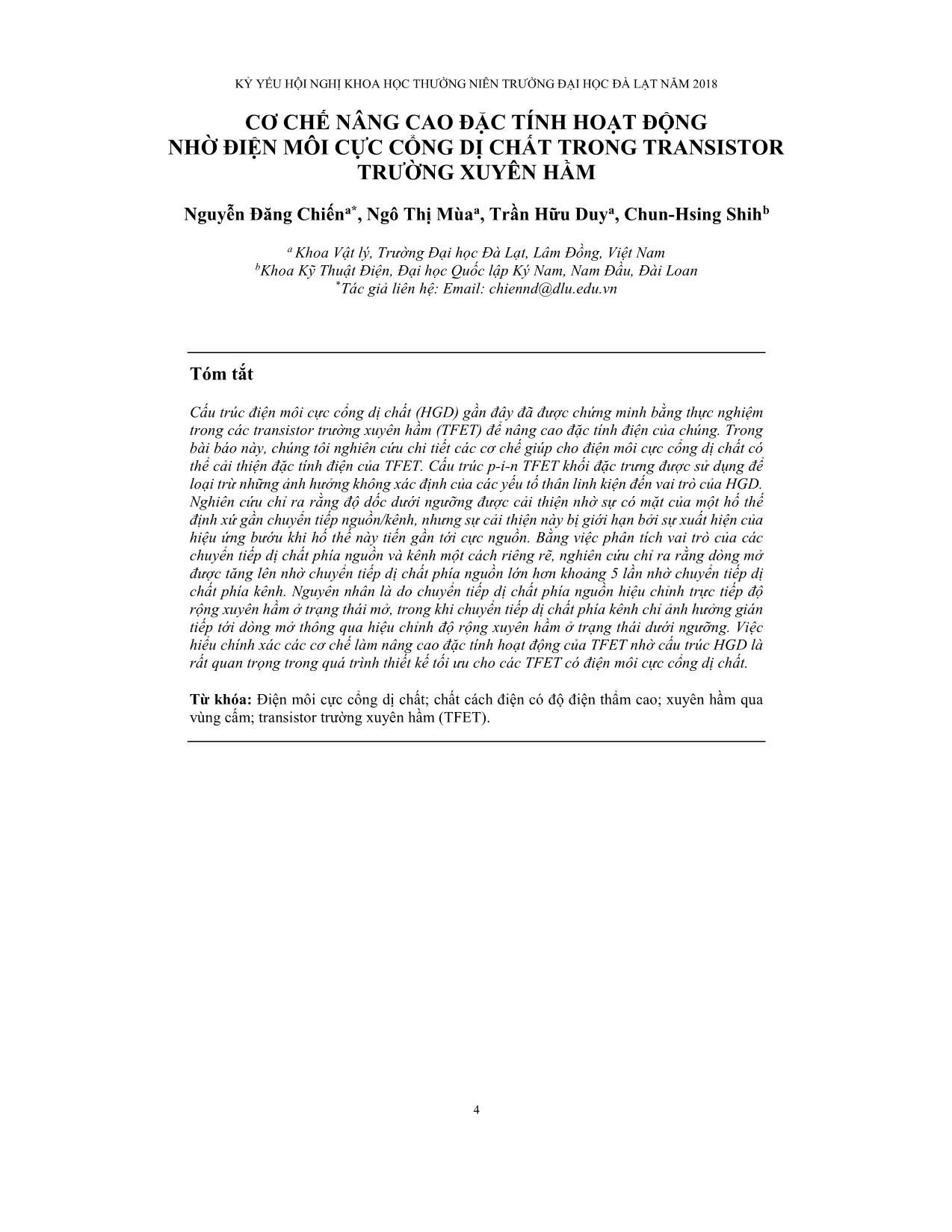
Trang 2
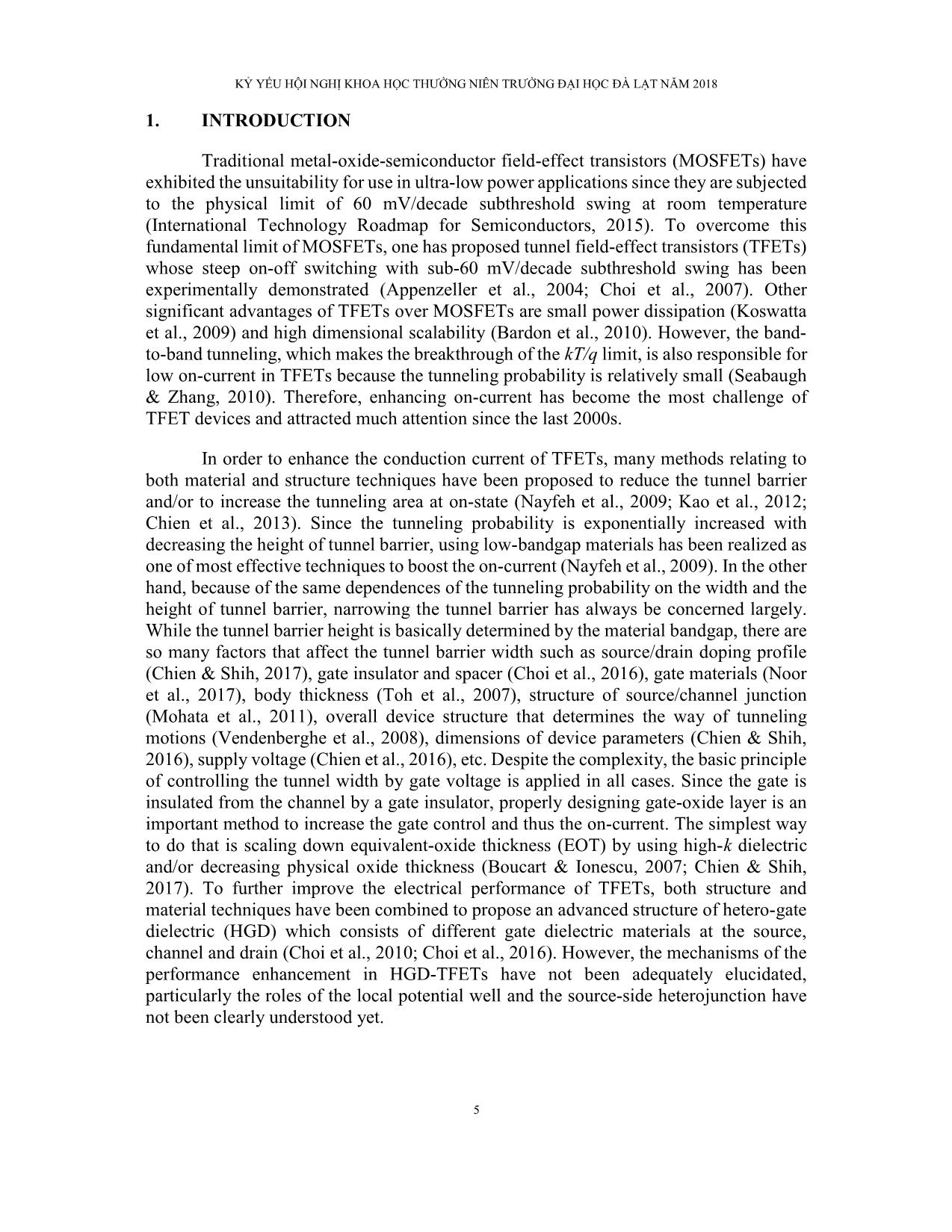
Trang 3
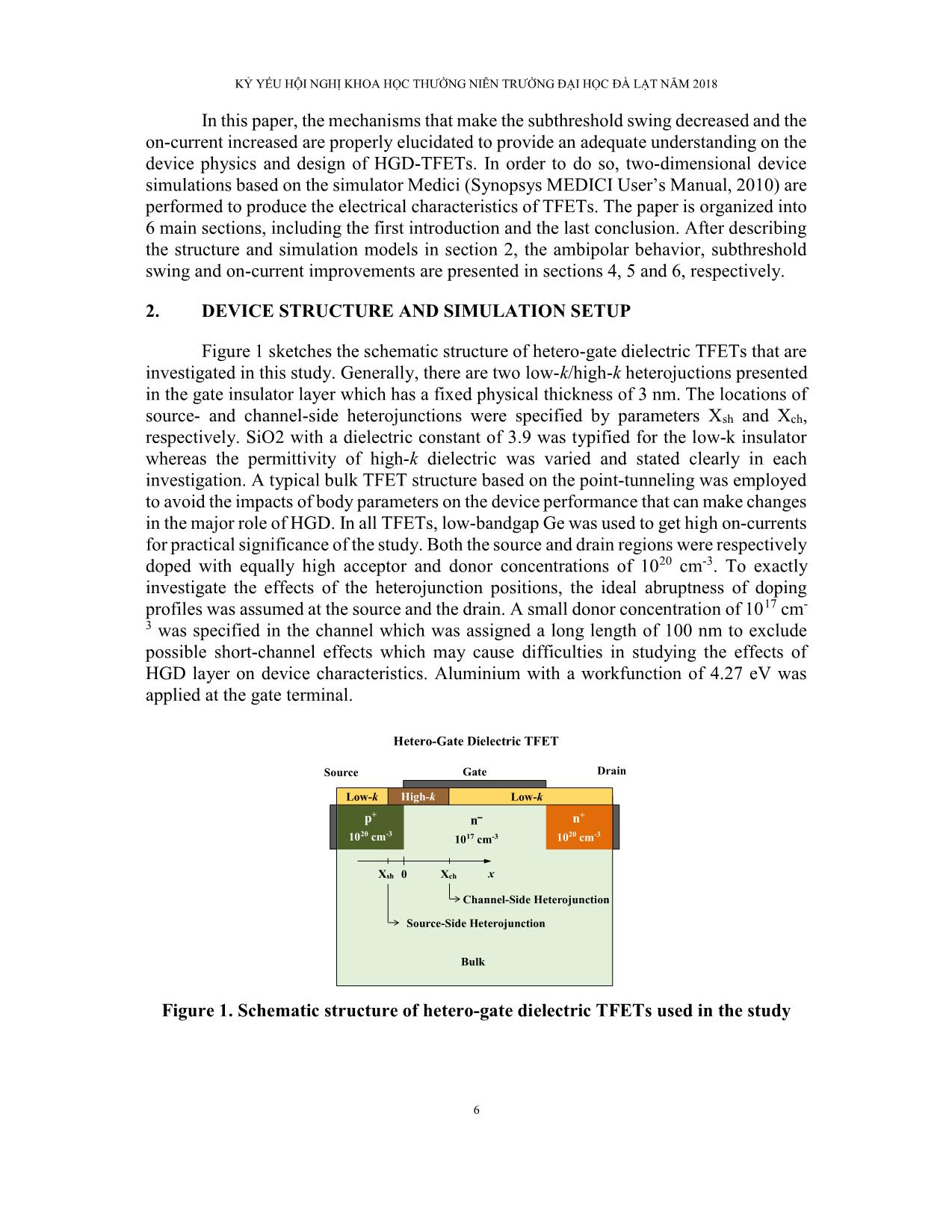
Trang 4
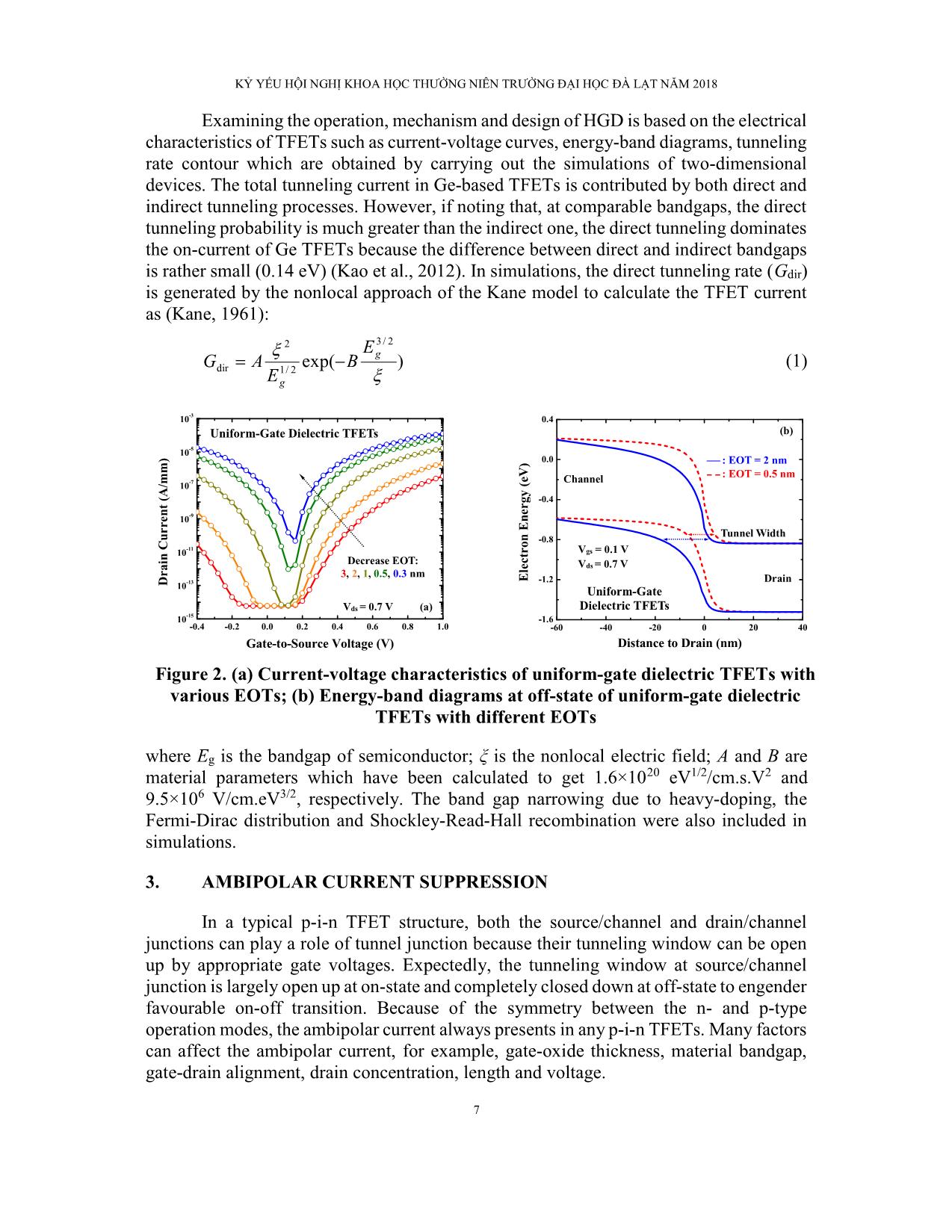
Trang 5
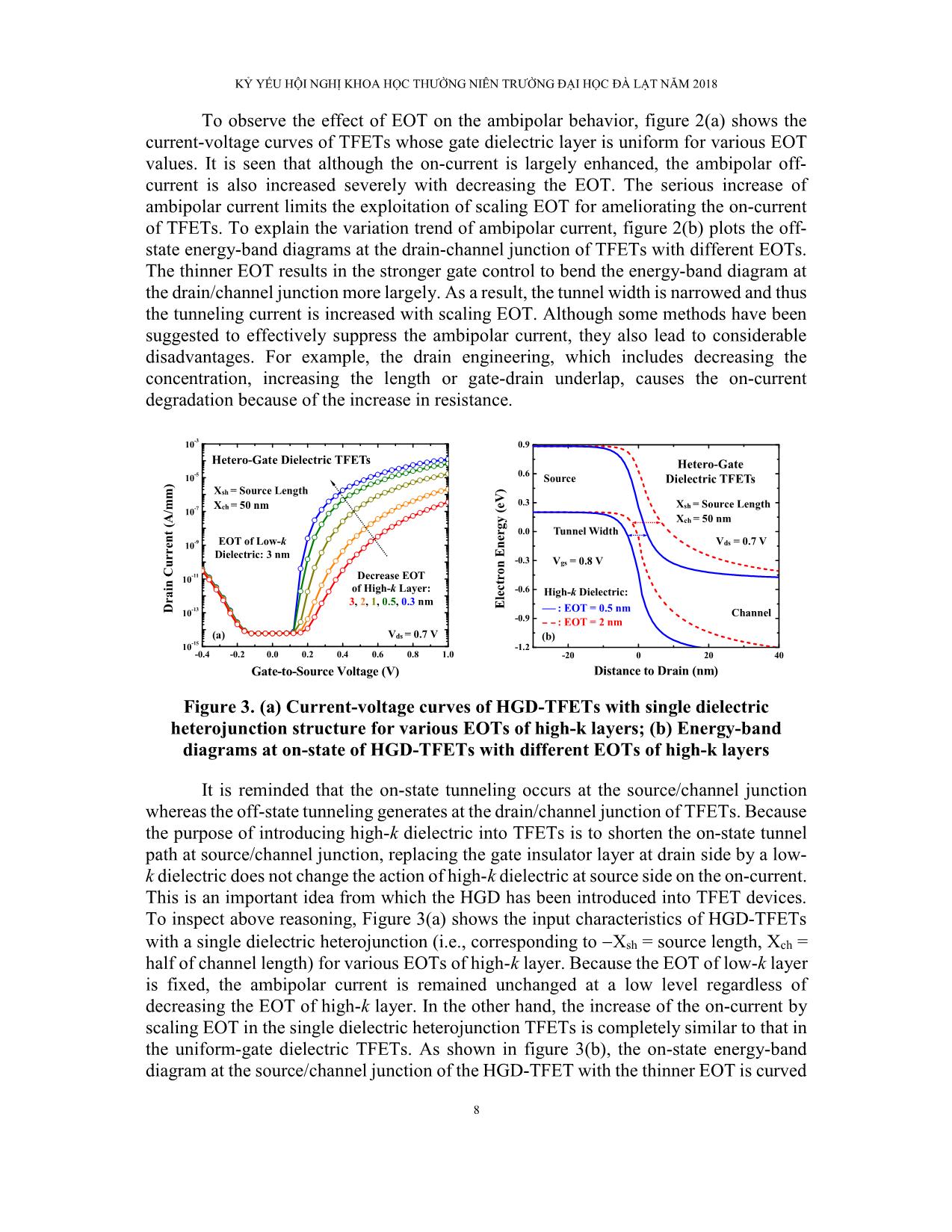
Trang 6
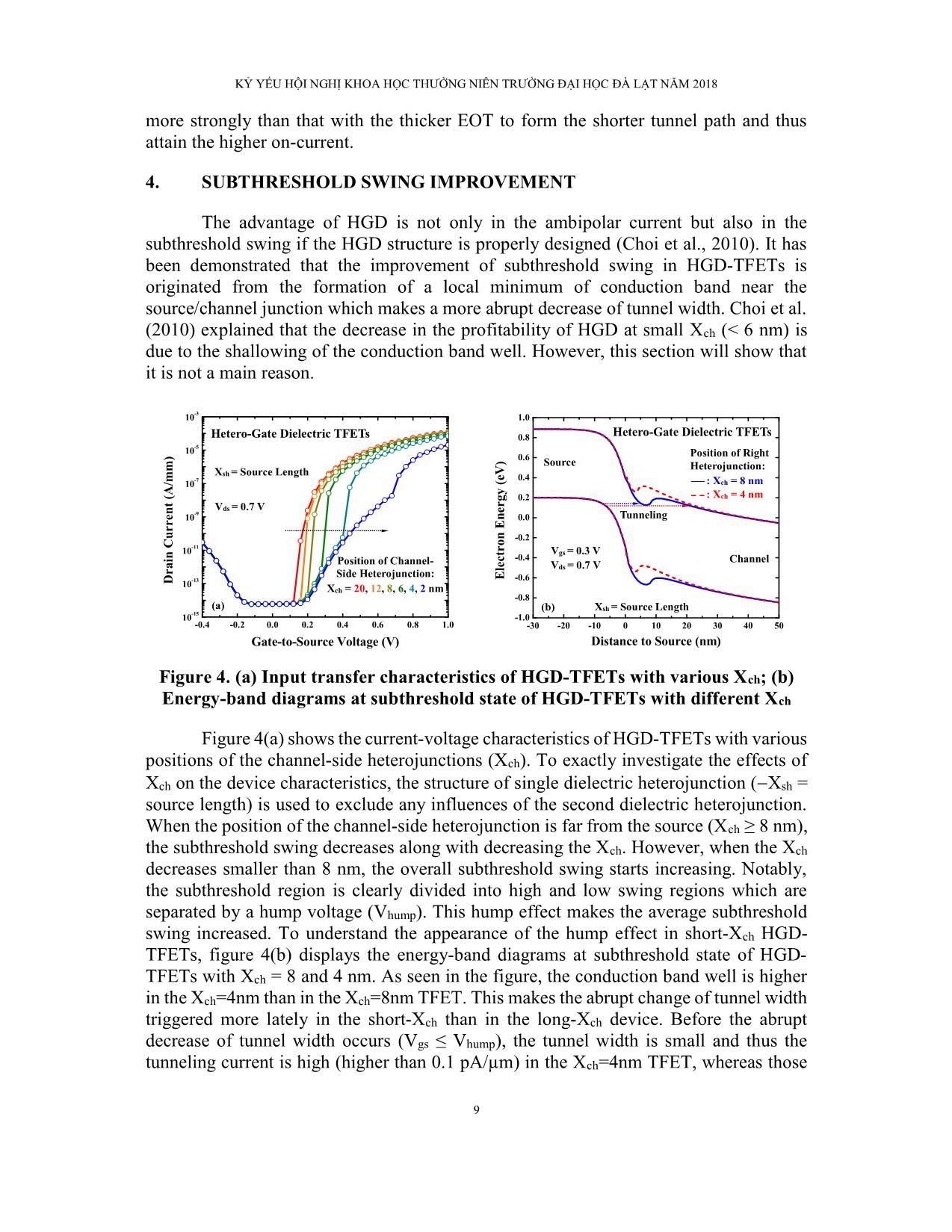
Trang 7
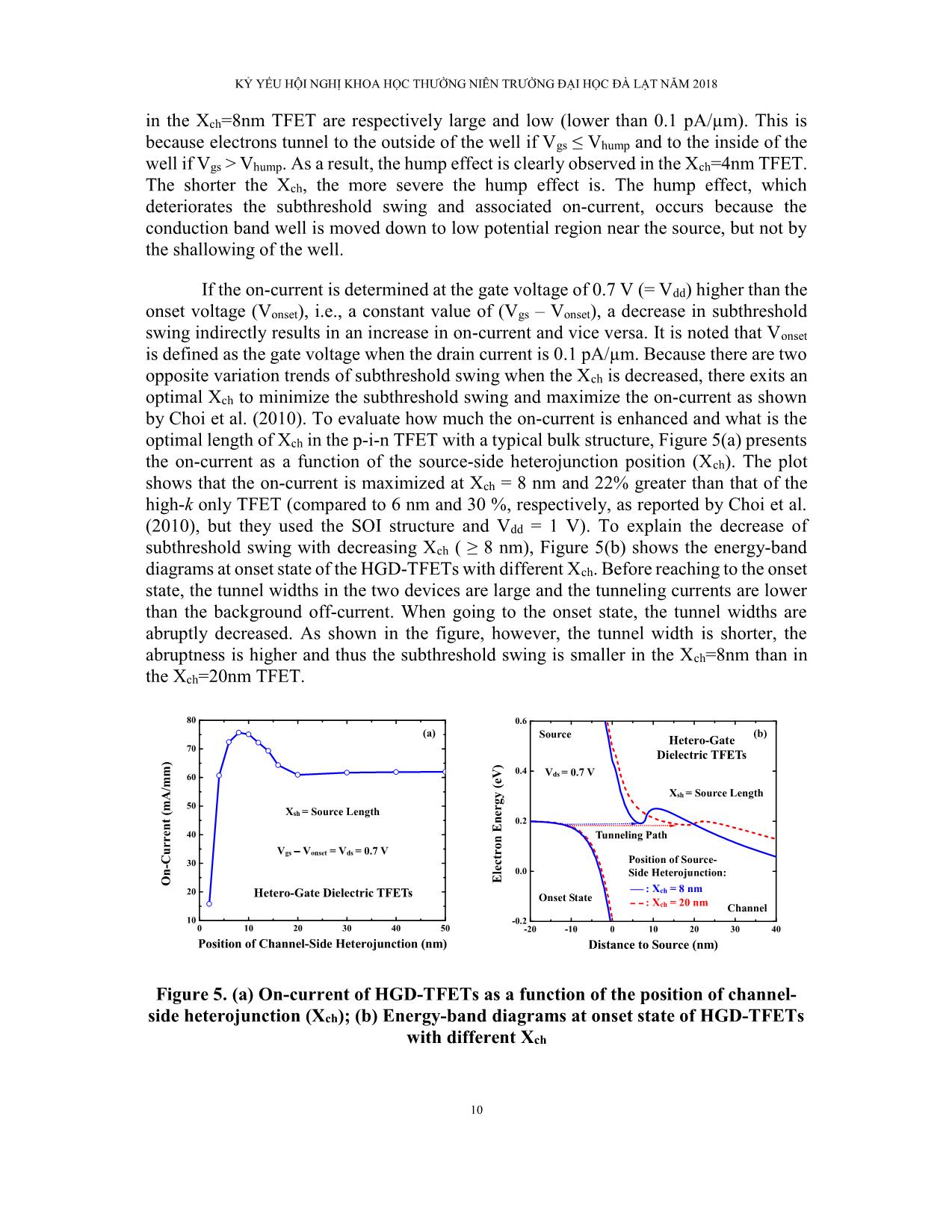
Trang 8
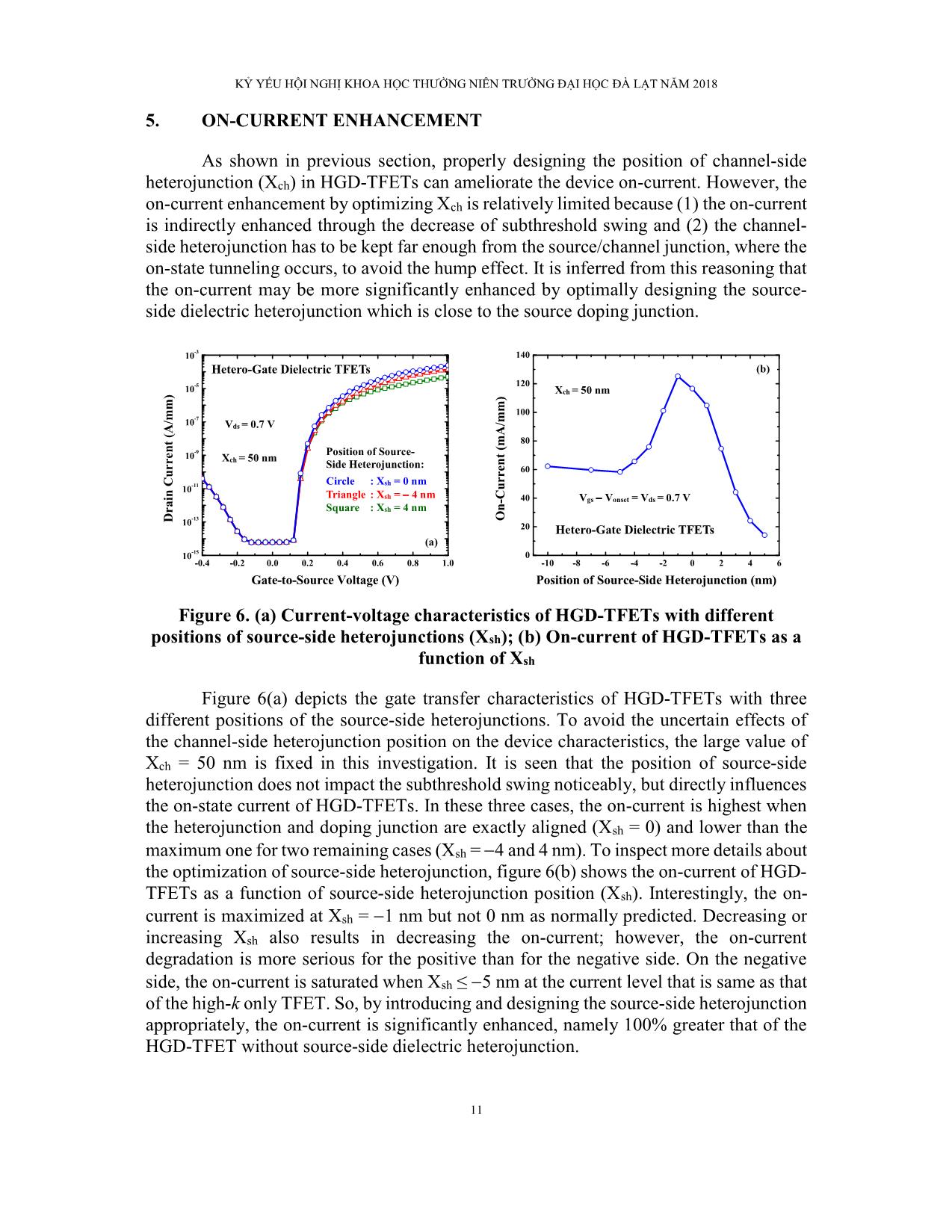
Trang 9
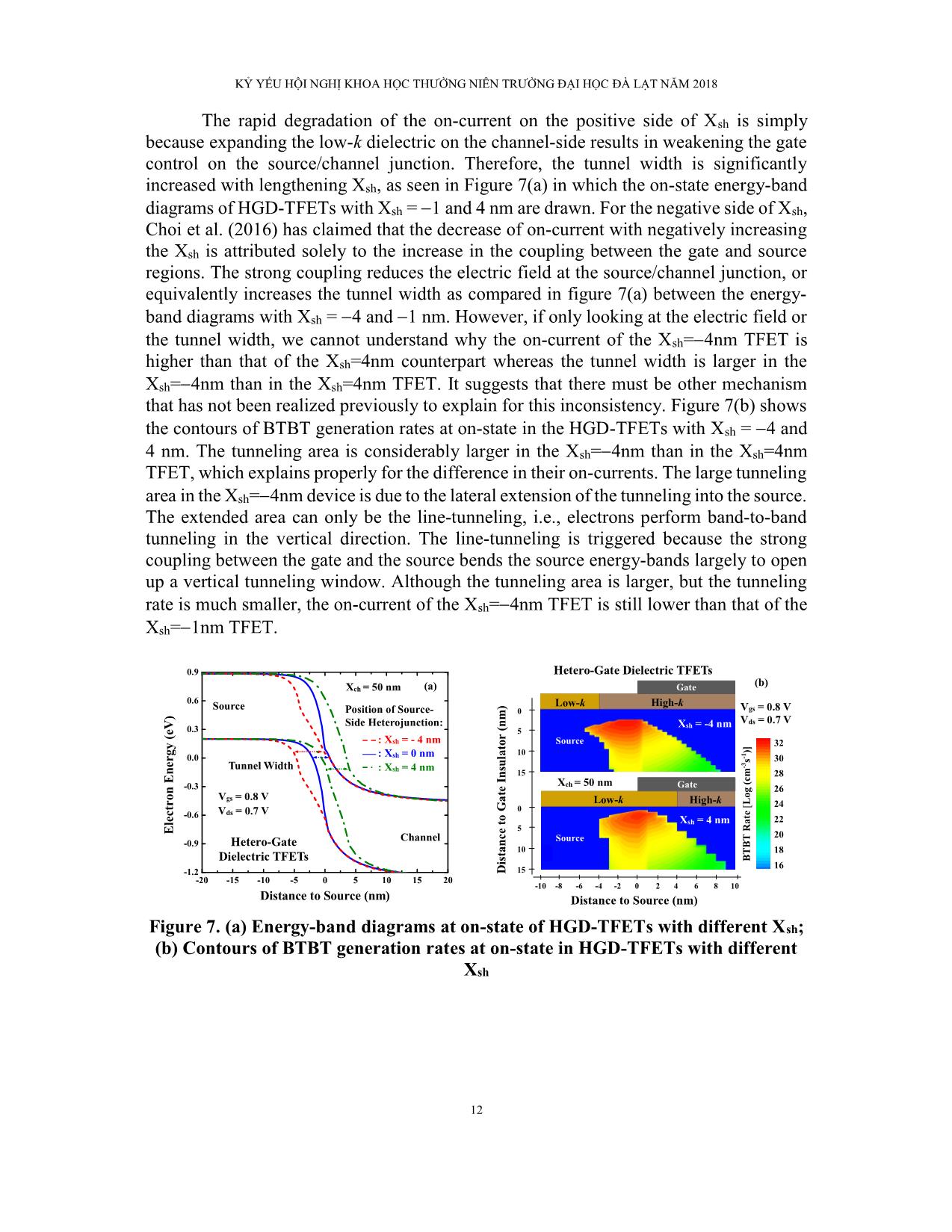
Trang 10
Tải về để xem bản đầy đủ
Tóm tắt nội dung tài liệu: Mechanisms of the performance enhancement by hetero - Gate dielectric in tunnel field - effect transistors
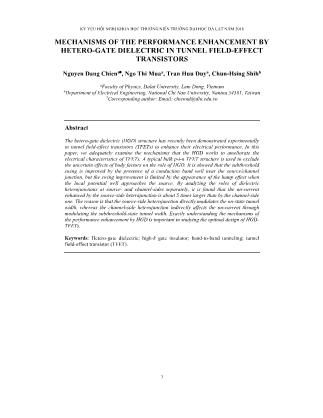
KỶ YẾU HỘI NGHỊ KHOA HỌC THƯỜNG NIÊN TRƯỜNG ĐẠI HỌC ĐÀ LẠT NĂM 2018 3 MECHANISMS OF THE PERFORMANCE ENHANCEMENT BY HETERO-GATE DIELECTRIC IN TUNNEL FIELD-EFFECT TRANSISTORS Nguyen Dang Chiena , Ngo Thi Muaa, Tran Huu Duya, Chun-Hsing Shihb aFaculty of Physics, Dalat University, Lam Dong, Vietnam bDepartment of Electrical Engineering, National Chi Nan University, Nantou 54561, Taiwan *Corresponding author: Email: chiennd@dlu.edu.vn Abstract The hetero-gate dielectric (HGD) structure has recently been demonstrated experimentally in tunnel field-effect transistors (TFETs) to enhance their electrical performance. In this paper, we adequately examine the mechanisms that the HGD works to ameliorate the electrical characteristics of TFETs. A typical bulk p-i-n TFET structure is used to exclude the uncertain effects of body factors on the role of HGD. It is showed that the subthreshold swing is improved by the presence of a conduction band well near the source/channel junction, but the swing improvement is limited by the appearance of the hump effect when the local potential well approaches the source. By analyzing the roles of dielectric heterojunctions at source- and channel-sides separately, it is found that the on-current enhanced by the source-side heterojunction is about 5 times larger than by the channel-side one. The reason is that the source-side heterojunction directly modulates the on-state tunnel width, whereas the channel-side heterojunction indirectly affects the on-current through modulating the subthreshold-state tunnel width. Exactly understanding the mechanisms of the performance enhancement by HGD is important in studying the optimal design of HGD- TFETs. Keywords: Hetero-gate dielectric; high-k gate insulator; band-to-band tunneling; tunnel field-effect transistor (TFET). KỶ YẾU HỘI NGHỊ KHOA HỌC THƯỜNG NIÊN TRƯỜNG ĐẠI HỌC ĐÀ LẠT NĂM 2018 4 CƠ CHẾ NÂNG CAO ĐẶC TÍNH HOẠT ĐỘNG NHỜ ĐIỆN MÔI CỰC CỔNG DỊ CHẤT TRONG TRANSISTOR TRƯỜNG XUYÊN HẦM Nguyễn Đăng Chiếna*, Ngô Thị Mùaa, Trần Hữu Duya, Chun-Hsing Shihb a Khoa Vật lý, Trường Đại học Đà Lạt, Lâm Đồng, Việt Nam bKhoa Kỹ Thuật Điện, Đại học Quốc lập Ký Nam, Nam Đầu, Đài Loan *Tác giả liên hệ: Email: chiennd@dlu.edu.vn Tóm tắt Cấu trúc điện môi cực cổng dị chất (HGD) gần đây đã được chứng minh bằng thực nghiệm trong các transistor trường xuyên hầm (TFET) để nâng cao đặc tính điện của chúng. Trong bài báo này, chúng tôi nghiên cứu chi tiết các cơ chế giúp cho điện môi cực cổng dị chất có thể cải thiện đặc tính điện của TFET. Cấu trúc p-i-n TFET khối đặc trưng được sử dụng để loại trừ những ảnh hưởng không xác định của các yếu tố thân linh kiện đến vai trò của HGD. Nghiên cứu chỉ ra rằng độ dốc dưới ngưỡng được cải thiện nhờ sự có mặt của một hố thế định xứ gần chuyển tiếp nguồn/kênh, nhưng sự cải thiện này bị giới hạn bởi sự xuất hiện của hiệu ứng bướu khi hố thế này tiến gần tới cực nguồn. Bằng việc phân tích vai trò của các chuyển tiếp dị chất phía nguồn và kênh một cách riêng rẽ, nghiên cứu chỉ ra rằng dòng mở được tăng lên nhờ chuyển tiếp dị chất phía nguồn lớn hơn khoảng 5 lần nhờ chuyển tiếp dị chất phía kênh. Nguyên nhân là do chuyển tiếp dị chất phía nguồn hiệu chỉnh trực tiếp độ rộng xuyên hầm ở trạng thái mở, trong khi chuyển tiếp dị chất phía kênh chỉ ảnh hưởng gián tiếp tới dòng mở thông qua hiệu chỉnh độ rộng xuyên hầm ở trạng thái dưới ngưỡng. Việc hiểu chính xác các cơ chế làm nâng cao đặc tính hoạt động của TFET nhờ cấu trúc HGD là rất quan trọng trong quá trình thiết kế tối ưu cho các TFET có điện môi cực cổng dị chất. Từ khóa: Điện môi cực cổng dị chất; chất cách điện có độ điện thẩm cao; xuyên hầm qua vùng cấm; transistor trường xuyên hầm (TFET). KỶ YẾU HỘI NGHỊ KHOA HỌC THƯỜNG NIÊN TRƯỜNG ĐẠI HỌC ĐÀ LẠT NĂM 2018 5 1. INTRODUCTION Traditional metal-oxide-semiconductor field-effect transistors (MOSFETs) have exhibited the unsuitability for use in ultra-low power applications since they are subjected to the physical limit of 60 mV/decade subthreshold swing at room temperature (International Technology Roadmap for Semiconductors, 2015). To overcome this fundamental limit of MOSFETs, one has proposed tunnel field-effect transistors (TFETs) whose steep on-off switching with sub-60 mV/decade subthreshold swing has been experimentally demonstrated (Appenzeller et al., 2004; Choi et al., 2007). Other significant advantages of TFETs over MOSFETs are small power dissipation (Koswatta et al., 2009) and high dimensional scalability (Bardon et al., 2010). However, the band- to-band tunneling, which makes the breakthrough of the kT/q limit, is also responsible for low on-current in TFETs because the tunneling probability is relatively small (Seabaugh & Zhang, 2010). Therefore, enhancing on-current has become the most challenge of TFET devices and attracted much attention since the last 2000s. In order to enhance the conduction current of TFETs, many methods relating to both material and structure techniques have been proposed to reduce the tunnel barrier and/or to increase the tunneling area at on-state (Nayfeh et al., 2009; Kao et al., 2012; Chien et al., 2013). Since the tunneling probability is exponentially increased with decreasing the height of tunnel barrier, using low-bandgap materials has been realized as one of most effective techniques to boost the on-current (Nayfeh et al., 2009). In the other hand, because of the same dependences of the tunneling probability on the width and the height of tunnel barrier, narrowing the tunnel barrier has always be concerned largely. While the tunnel barrier height is basically determined by the material bandgap, there are so many factors that affect the tunnel barrier width such as source/drain doping profile (Chien & Shih, 2017), gate insulator and spacer (Choi et al., 2016), gate materials (Noor et al., 2017), body thickn ... G ĐẠI HỌC ĐÀ LẠT NĂM 2018 10 in the Xch=8nm TFET are respectively large and low (lower than 0.1 pA/µm). This is because electrons tunnel to the outside of the well if Vgs ≤ Vhump and to the inside of the well if Vgs > Vhump. As a result, the hump effect is clearly observed in the Xch=4nm TFET. The shorter the Xch, the more severe the hump effect is. The hump effect, which deteriorates the subthreshold swing and associated on-current, occurs because the conduction band well is moved down to low potential region near the source, but not by the shallowing of the well. If the on-current is determined at the gate voltage of 0.7 V (= Vdd) higher than the onset voltage (Vonset), i.e., a constant value of (Vgs – Vonset), a decrease in subthreshold swing indirectly results in an increase in on-current and vice versa. It is noted that Vonset is defined as the gate voltage when the drain current is 0.1 pA/µm. Because there are two opposite variation trends of subthreshold swing when the Xch is decreased, there exits an optimal Xch to minimize the subthreshold swing and maximize the on-current as shown by Choi et al. (2010). To evaluate how much the on-current is enhanced and what is the optimal length of Xch in the p-i-n TFET with a typical bulk structure, Figure 5(a) presents the on-current as a function of the source-side heterojunction position (Xch). The plot shows that the on-current is maximized at Xch = 8 nm and 22% greater than that of the high-k only TFET (compared to 6 nm and 30 %, respectively, as reported by Choi et al. (2010), but they used the SOI structure and Vdd = 1 V). To explain the decrease of subthreshold swing with decreasing Xch ( ≥ 8 nm), Figure 5(b) shows the energy-band diagrams at onset state of the HGD-TFETs with different Xch. Before reaching to the onset state, the tunnel widths in the two devices are large and the tunneling currents are lower than the background off-current. When going to the onset state, the tunnel widths are abruptly decreased. As shown in the figure, however, the tunnel width is shorter, the abruptness is higher and thus the subthreshold swing is smaller in the Xch=8nm than in the Xch=20nm TFET. 0 10 20 30 40 50 10 20 30 40 50 60 70 80 O n- C ur re nt (m A /m m ) Position of Channel-Side Heterojunction (nm) Hetero-Gate Dielectric TFETs Vgs Vonset = Vds = 0.7 V (a) Xsh = Source Length -20 -10 0 10 20 30 40 -0.2 0.0 0.2 0.4 0.6 El ec tr on E ne rg y (e V ) Distance to Source (nm) Hetero-Gate Dielectric TFETs Onset State Channel (b) Source Tunneling Path : Xch = 8 nm : Xch = 20 nm Vds = 0.7 V Position of Source- Side Heterojunction: Xsh = Source Length Figure 5. (a) On-current of HGD-TFETs as a function of the position of channel- side heterojunction (Xch); (b) Energy-band diagrams at onset state of HGD-TFETs with different Xch KỶ YẾU HỘI NGHỊ KHOA HỌC THƯỜNG NIÊN TRƯỜNG ĐẠI HỌC ĐÀ LẠT NĂM 2018 11 5. ON-CURRENT ENHANCEMENT As shown in previous section, properly designing the position of channel-side heterojunction (Xch) in HGD-TFETs can ameliorate the device on-current. However, the on-current enhancement by optimizing Xch is relatively limited because (1) the on-current is indirectly enhanced through the decrease of subthreshold swing and (2) the channel- side heterojunction has to be kept far enough from the source/channel junction, where the on-state tunneling occurs, to avoid the hump effect. It is inferred from this reasoning that the on-current may be more significantly enhanced by optimally designing the source- side dielectric heterojunction which is close to the source doping junction. -0.4 -0.2 0.0 0.2 0.4 0.6 0.8 1.0 10-15 10-13 10-11 10-9 10-7 10-5 10-3 D ra in C ur re nt (A /m m ) Gate-to-Source Voltage (V) Hetero-Gate Dielectric TFETs Position of Source- Side Heterojunction: Circle : Xsh = 0 nm Triangle : Xsh = 4 nm Square : Xsh = 4 nm Vds = 0.7 V (a) Xch = 50 nm -10 -8 -6 -4 -2 0 2 4 6 0 20 40 60 80 100 120 140 O n- C ur re nt (m A /m m ) Position of Source-Side Heterojunction (nm) Hetero-Gate Dielectric TFETs Vgs Vonset = Vds = 0.7 V (b) Xch = 50 nm Figure 6. (a) Current-voltage characteristics of HGD-TFETs with different positions of source-side heterojunctions (Xsh); (b) On-current of HGD-TFETs as a function of Xsh Figure 6(a) depicts the gate transfer characteristics of HGD-TFETs with three different positions of the source-side heterojunctions. To avoid the uncertain effects of the channel-side heterojunction position on the device characteristics, the large value of Xch = 50 nm is fixed in this investigation. It is seen that the position of source-side heterojunction does not impact the subthreshold swing noticeably, but directly influences the on-state current of HGD-TFETs. In these three cases, the on-current is highest when the heterojunction and doping junction are exactly aligned (Xsh = 0) and lower than the maximum one for two remaining cases (Xsh = 4 and 4 nm). To inspect more details about the optimization of source-side heterojunction, figure 6(b) shows the on-current of HGD- TFETs as a function of source-side heterojunction position (Xsh). Interestingly, the on- current is maximized at Xsh = 1 nm but not 0 nm as normally predicted. Decreasing or increasing Xsh also results in decreasing the on-current; however, the on-current degradation is more serious for the positive than for the negative side. On the negative side, the on-current is saturated when Xsh ≤ 5 nm at the current level that is same as that of the high-k only TFET. So, by introducing and designing the source-side heterojunction appropriately, the on-current is significantly enhanced, namely 100% greater that of the HGD-TFET without source-side dielectric heterojunction. KỶ YẾU HỘI NGHỊ KHOA HỌC THƯỜNG NIÊN TRƯỜNG ĐẠI HỌC ĐÀ LẠT NĂM 2018 12 The rapid degradation of the on-current on the positive side of Xsh is simply because expanding the low-k dielectric on the channel-side results in weakening the gate control on the source/channel junction. Therefore, the tunnel width is significantly increased with lengthening Xsh, as seen in Figure 7(a) in which the on-state energy-band diagrams of HGD-TFETs with Xsh = 1 and 4 nm are drawn. For the negative side of Xsh, Choi et al. (2016) has claimed that the decrease of on-current with negatively increasing the Xsh is attributed solely to the increase in the coupling between the gate and source regions. The strong coupling reduces the electric field at the source/channel junction, or equivalently increases the tunnel width as compared in figure 7(a) between the energy- band diagrams with Xsh = 4 and 1 nm. However, if only looking at the electric field or the tunnel width, we cannot understand why the on-current of the Xsh= 4nm TFET is higher than that of the Xsh=4nm counterpart whereas the tunnel width is larger in the Xsh= 4nm than in the Xsh=4nm TFET. It suggests that there must be other mechanism that has not been realized previously to explain for this inconsistency. Figure 7(b) shows the contours of BTBT generation rates at on-state in the HGD-TFETs with Xsh = 4 and 4 nm. The tunneling area is considerably larger in the Xsh= 4nm than in the Xsh=4nm TFET, which explains properly for the difference in their on-currents. The large tunneling area in the Xsh= 4nm device is due to the lateral extension of the tunneling into the source. The extended area can only be the line-tunneling, i.e., electrons perform band-to-band tunneling in the vertical direction. The line-tunneling is triggered because the strong coupling between the gate and the source bends the source energy-bands largely to open up a vertical tunneling window. Although the tunneling area is larger, but the tunneling rate is much smaller, the on-current of the Xsh= 4nm TFET is still lower than that of the Xsh= 1nm TFET. -20 -15 -10 -5 0 5 10 15 20 -1.2 -0.9 -0.6 -0.3 0.0 0.3 0.6 0.9 El ec tr on E ne rg y (e V ) Distance to Source (nm) Hetero-Gate Dielectric TFETs Vgs = 0.8 V Vds = 0.7 V Channel (a) Source Tunnel Width Position of Source- Side Heterojunction: : Xsh = - 4 nm : Xsh = 0 nm : Xsh = 4 nm Xch = 50 nm (b) Distance to Source (nm) 0 5 -10 D is ta nc e to G at e In su la to r (n m ) -8 -6 -4 Hetero-Gate Dielectric TFETs Low-k Source 10 15 -2 0 Vgs = 0.8 V Vds = 0.7 V High-k Low-k High-k Gate Gate 0 5 10 15 2 4 6 8 10 Source 32 30 28 26 24 22 20 18 16 BT BT R at e [L og (c m -3 s-1 )] Xsh = -4 nm Xsh = 4 nm Xch = 50 nm Figure 7. (a) Energy-band diagrams at on-state of HGD-TFETs with different Xsh; (b) Contours of BTBT generation rates at on-state in HGD-TFETs with different Xsh KỶ YẾU HỘI NGHỊ KHOA HỌC THƯỜNG NIÊN TRƯỜNG ĐẠI HỌC ĐÀ LẠT NĂM 2018 13 6. CONCLUSION By using two-dimensional numerical simulations, the device physics of HGD- TFETs has been explored to achieve an adequate understanding on the mechanisms of how the TFET performance is enhanced by the HGD. The suppression of detrimental hump effect, which emerges in HGD-TFETs with a short high-k layer, is expected to exploit the benefit of HGD effectively. In addition, the source-side heterojunction has to be more carefully designed and fabricated because the on-current of HGD-TFETs is more sensitive on the position of the source- than on the channel-side heterojunction. ACKNOWLEDGMENTS This research is funded by the Ministry of Education & Training and Dalat University, Vietnam. This work is also supported by the National Center for High- Performance Computing of Taiwan. REFERENCES Appenzeller, J., Lin, Y.-M., Knoch, J., & Avouris Ph. (2004). Band-to-band tunneling in carbon nanotube field-effect transistors! Phys. Rev. Lett., 93(19), 196905. Bardon, M. G., Neves, H. P., Puers R., & Hoof, C. V. (2010). Pseudo-two-dimensional model for double-gate tunnel FETs considering the junctions depletion regions! IEEE Trans. Electron Devices, 57(4), 827-834. Boucart, K. & Ionescu, A. M. (2007). Double-gate tunnel FET with high-κ gate dielectric! IEEE Trans. Electron Devices, 54(7), 1725-1733. Chien, N.D. & Shih, C.-H. (2016). Short channel effects in tunnel field-effect transistors with different configurations of abrupt and graded Si/SiGe heterojunctions, Superlattices Microstruct., 100, 857-866. Chien, N.D. & Shih, C.-H. (2017). Oxide thickness-dependent effects of source doping profile on the performance of single- and double-gate tunnel field-effect transistors! Superlattices Microstruct., 102, 284-299. Chien, N.D., Shih, C.-H., & Vinh, L.T. (2013). Drive current enhancement in tunnel field- effect transistors by graded heterojunction approach! J. Appl. Phys., 114(9), 094507 [Erratum! 114(18), 189901]. Chien, N.D., Shih, C.-H., Chen, Y.-H., & Thu, N.T. (2016, January). Increasing drain voltage of low-bandgap tunnel field-effect transistors by drain engineering. Presented at the International Conference Electronics, Information and Communications, Vietnam. Retrieved from Choi, W. Y. & Lee, H. K. (2016). Demonstration of hetero-gate-dielectric tunneling field- effect transistors (HG TFETs)! Nano Convergence, 3(1), 1-15. Choi, W. Y. & Lee, W. (2010). Hetero-gate-dielectric tunneling field-effect transistors! KỶ YẾU HỘI NGHỊ KHOA HỌC THƯỜNG NIÊN TRƯỜNG ĐẠI HỌC ĐÀ LẠT NĂM 2018 14 IEEE Trans. Electron Devices, 57(9), 2317-2319. Choi, W. Y., Park, B.-G., Lee, J. D., & Liu, T.-J. K. (2007). Tunneling field-effect transistors (TFETs) with subthreshold swing (SS) less than 60 mV/dec! IEEE Electron Device Lett., 28(8), 743-745. International Technology Roadmap for Semiconductors. More Moore. (2015) (available at Kao, K.-H., Verhulst, A.S., Vandenberghe, W.G., Soree, B., Groeseneken, G., & Meyer, K.D. (2012). Direct and indirect band-to-band tunneling in germanium-based TFETs! IEEE Trans. Electron Devices, 59(2), 292-301. Koswatta, S.O., Lundstrom, M.S., & Nikonov, D.E. (2009). Performance comparison between p-i-n tunneling transistors and conventional MOSFETs! IEEE Trans. Electron Devices, 56(3), 456-465. Mohata, D., Mookerjea, S., Agrawal, A., Li, Y., Mayer, T., Narayanan, V., Liu, A., Loubychev, D., Fastenau, J., & Datta, S. (2011). Experimental staggered-source and N+ pocket-doped channel III–V tunnel field-effect transistors and their scalabilities! Appl. Phys. Exp., 4 (2) 024105. Nayfeh, O. M., Hoyt, J. L., & Antoniadis, D. A. (2009). Strained-Si1-xGex/Si band-to- band tunneling transistors: Impact of tunnel junction germanium composition and doping concentration on switching behavior! IEEE Trans. Electron Devices, 56(10), 2264-2269. Noor, S. L., Safa, S., & Khan, Md. Z. R. (2017). A silicon-based dual-material double- gate TFET with optimized performance! Int. J. Numer. Model. Electronic Networks, Devices and Fields, 30(6), e2220. Seabaugh, A. C. & Zhang, Q. (2010). Low voltage tunnel transistors for beyond CMOS logic! Proceedings of the IEEE, 98(12), 2095-2110. Synopsys MEDICI User’s Manual (California: Synopsys Inc.). 2010. Toh, E.-H., Wang, G. H., Chan, L., Samudra, G., & Yeo, Y.-C. (2007). Device physics and design of double-gate tunneling field-effect transistor by silicon film thickness optimization! Appl. Phys. Lett., 90(26), 263507. Vandenberghe W. G., Verhulst A. S., Groeseneken G., Soree B., & Magnus W. (2008, September). Analytical model for point and line tunneling in a tunnel field-effect transistor. Paper presented at the International Conference on Simulation of Semiconductor Processes and Devices, Japan. Retrieved from
File đính kèm:
 mechanisms_of_the_performance_enhancement_by_hetero_gate_die.pdf
mechanisms_of_the_performance_enhancement_by_hetero_gate_die.pdf

